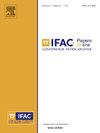识别基于脑电图的全脑功能网络模型
Q3 Engineering
引用次数: 0
摘要
大脑活动根据意识状态的不同而不同。全脑模型,通常基于功能磁共振成像(fMRI)数据,通过利用结构连通性和微分方程来模拟大脑区域之间的功能连通性,为这些变化提供了有价值的见解。这项工作的目标是使基于功能磁共振成像的功能连接模型适应脑电图数据。该过程的关键步骤是确定聚类数量和估计耦合参数。我们转向振幅包络相关,一种时域测量,以更好地匹配功能mri中观察到的功能连接模式。通过分析来自AlphaMax研究的25名60岁以上男性受试者的64通道脑电图数据,我们研究了麻醉下的觉醒和向无意识的过渡。使用A均值聚类,我们确定了最佳的大脑网络配置,重点关注它们是否与已知的基于fmri的网络相匹配。对于不同的阈值和聚类数量,使用Calinski-Harabasz准则进行聚类评估。结果表明,对于清醒和半清醒半无意识的混合场景,两个集群都是最优的。错位电极主要出现在顶叶区域。由于我们确定了微分方程的数量,这项工作为进一步开发基于脑电图的全脑模型奠定了基础,该模型可以跟踪麻醉期间功能连接的变化。本文章由计算机程序翻译,如有差异,请以英文原文为准。
Identifying EEG-based Functional Networks for Whole-Brain Models
Brain activity differs according to the state of consciousness. Whole-brain models, typically based on functional magnetic resonance imaging (fMRI) data, provide valuable insight into these changes by utilizing structural connectivity and differential equations to model the functional connectivity between brain regions. The goal of this work is to adapt fMRI-based functional connectivity models to electroencephalography data. A key step in this process is to determine the number of clusters and to estimate the coupling parameters. We turn to amplitude envelope correlation, a time-domain measure, to better match functional connectivity patterns observed in fMRI. By analyzing 64-channel electroencephalogram data from 25 male subjects over the age of 60 from the AlphaMax study, we investigate wakefulness and the transition to unconsciousness under anesthesia. Using A;-means clustering, we identify optimal brain network configurations, focusing on whether they match known fMRI-based networks. Clustering is evaluated using the Calinski-Harabasz criterion for different thresholds and numbers of cluster. The results show that two clusters are predominantly optimal for both awake and the mixed half awake, half unconscious scenario. Misplaced electrodes are mainly found in parietal regions. Since we determined the number of differential equations, this work lays the foundation for further development of electroencephalography-based whole-brain models that can track functional connectivity changes during anesthesia.
求助全文
通过发布文献求助,成功后即可免费获取论文全文。
去求助
来源期刊

IFAC-PapersOnLine
Engineering-Control and Systems Engineering
CiteScore
1.70
自引率
0.00%
发文量
1122
期刊介绍:
All papers from IFAC meetings are published, in partnership with Elsevier, the IFAC Publisher, in theIFAC-PapersOnLine proceedings series hosted at the ScienceDirect web service. This series includes papers previously published in the IFAC website.The main features of the IFAC-PapersOnLine series are: -Online archive including papers from IFAC Symposia, Congresses, Conferences, and most Workshops. -All papers accepted at the meeting are published in PDF format - searchable and citable. -All papers published on the web site can be cited using the IFAC PapersOnLine ISSN and the individual paper DOI (Digital Object Identifier). The site is Open Access in nature - no charge is made to individuals for reading or downloading. Copyright of all papers belongs to IFAC and must be referenced if derivative journal papers are produced from the conference papers. All papers published in IFAC-PapersOnLine have undergone a peer review selection process according to the IFAC rules.
 求助内容:
求助内容: 应助结果提醒方式:
应助结果提醒方式:


